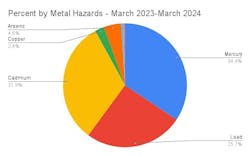News item from Feb. 26: Hershey Co. urged a California federal judge to dismiss a proposed class action suit that claimed some of the company’s dark chocolate products contain dangerous levels of lead and cadmium. Hershey said the small amounts of heavy metals in the chocolate are naturally occurring and are not dangerous.
That little news item illustrates how pervasive, incendiary and yet not necessarily toxic heavy metals are in food. And tacitly implies how difficult it is to detect and remove them.
Heavy metals in food have been of concern for a decade or more, but they made headlines last fall when unsafe amounts of lead were found in toddlers’ applesauce products from three American brands. However, in that case, the cause was intentional, economically motivated adulteration: A cinnamon grinder in Ecuador apparently added lead to increase the weight (and cost) of the cinnamon he sold to the contract manufacturer of those applesauce pouches, also in Ecuador.
Then, just last month, the FDA found lead in six ground cinnamon products in the U.S. and recommended a voluntary recall. This time, the source appears to be environmental. “It is important to note that the lead levels found in the ground cinnamon products listed … are significantly lower than lead levels in cinnamon in the recalled apple sauce pouches removed from the market this past fall,” the FDA noted.
Nevertheless, the cinnamon contaminations seem to have catalyzed a food safety agency that usually focuses on biological contaminants. Heavy metals have been a hot issue since about 2011, when consumer advocacy groups started reporting tests that showed lead, cadmium, arsenic and mercury in baby and toddler foods. Congressional calls for action followed.
A 2019 study by consumer advocacy group Healthy Babies Bright Futures found those four toxic metals in 94% of the baby/toddler foods they sampled. Lead was present in all 94% of the positive samples, and rice-based foods were the worst offenders.
The FDA’s first response was to note that the metals were present at acceptable levels … with the word acceptable igniting a firestorm. In early 2021, the FDA announced its “Closer to Zero” plan (see sidebar), promising an evaluation of the danger and proposals for “appropriate” levels for lead, cadmium, mercury and arsenic, in consultation with manufacturers, consumers and other stakeholders.
In many agricultural products
In chocolate, it’s not just Hershey. Consumer Reports in a December 2022 story found heavy metals – primarily cadmium and lead -- in chocolate from Theo, Trader Joe's and other popular brands, in addition to Hershey's.
“CR tested a mix of brands, including smaller ones … For 23 of the bars, eating just an ounce a day would put an adult over a level that public health authorities and CR’s experts say may be harmful for at least one of those heavy metals.”
And it’s not just chocolate. Certain products, mostly agricultural crops, are more prone to contain heavy metals because they’re more prone to absorb them from their environment. The list includes:
- Rice
- Root crops such as sweet potatoes, beets, white potatoes, carrots
- Grapes, apples, peaches, and pears (but not bananas or oranges)
- Squash, green beans, peas
- Spices
- Carrageenan and algae-derived products
Most of the contamination occurs when those plants absorb heavy metals from the soil and/or water. In some cases, the metals are naturally present in the ground; in others, the ground has been contaminated by outside sources.
The Consumer Reports researchers found that cacao plants take up cadmium from the soil, with the metal accumulating in cacao beans as the tree grows. That’s similar to how heavy metals contaminate some other foods.
But lead seems to get into cacao after beans are harvested. The researchers found the metal was typically on the outer shell of the cocoa bean, not in the bean itself. Moreover, lead levels were low soon after beans were picked and removed from pods but increased as beans dried in the sun for days. During that time, lead-filled dust and dirt accumulated on the beans. “We collected beans on the ground that were heavily loaded with lead on the outer shell,” one of the Consumer Reports researchers wrote.
While there may be just trace amounts of metals in the agricultural raw materials, the manufacturing process can increase their levels. “When you remove moisture and otherwise concentrate the ingredient, what was a barely detectable amount of heavy metal becomes a dangerous level,” explains Timothy Lombardo, senior director for food consulting services at EAS Consulting.
EAS is the consulting arm of the Certified Group of companies, with EAS providing regulatory compliance guidance to industries regulated by FDA, USDA and supporting agencies. The other companies in the Certified Group are Certfified Laboratories (which performs testing for FDA-regulated foods) and Food Safety Net Services (which specializes in USDA regulated foods).
And, of course, using more of a metal-prone ingredient in the finished product will raise the level of contaminant in the final product. Harkening back to those chocolate examples, dark chocolate tends to be higher in heavy metals than milk chocolate, apparently because of its higher cacao content.
Testing, 1,2,3
There is a standard battery of methods for testing for heavy metals in products and incoming ingredients. Although those analyses could be done by processors on site with the proper equipment, almost all food & beverage companies send samples to offsite labs.
“Testing for heavy metals in food is one of the most common analytical chemistry tests we perform at Certified Laboratories,” said a spokesman for that company. “Not only do we run the test on food products, but we also test for heavy metals in dietary supplements, cosmetics, spices, and other products. The same fundamental steps apply regardless of which product is being tested, although the precise methodology may change slightly.”
There are numerous other labs that offer the same services. If your products use those six ingredients listed earlier, you should test for heavy metals.
FoodChain ID uses the industry standard for heavy metal testing, ICP-MS -- inductively coupled plasma mass spectrometry -- the method recommended by the FDA. “We test at multiple nodes of the food chain from growers to processers, ingredient manufacturers, etc.,” says Heather Secrist, senior vice president of technical services-Americas.
“Based on the sample matrix and production setting, processors might not need to test for all four of the ‘Big 4’ [lead, cadmium, mercury and arsenic],” she continues. “The recommended heavy metal panel may well be different depending on the type of food product, the production setting (i.e. grain/seed grown in soil, a production or manufacturing setting where metal shavings might be an issue) and compliance to [California’s] Prop 65.”
The FDA has a lengthy and very technical explanation of the testing process in its “Elemental Analysis Manual for Food and Related Products”.
Moreover, “Processors are required to have a Hazard Analysis plan, and this [heavy metals testing] falls under hazard analysis,” says Lombardo. “If you use ingredients that are likely to have heavy metals, and especially if they come from suppliers in countries with lower food safety standards than ours, you better have a plan for testing for them. It is the manufacturer's responsibility to do the due diligence and identify these contaminants, just as they have safety protocols for E. Coli and salmonella or metal or glass fragments.”
He suggests thinking about it in three steps:
“One, is the ingredient likely to absorb heavy metals from the environment?
“Two, is the initial processing likely to add or concentrate heavy metals?
“Three, is your processing adding or concentrating any heavy metals present?”
Metals are naturally present in some cases and difficult to detect, but industry can do better, several observers say. Consumer Reports noted that while most of the chocolate bars it tested had concerning levels of lead, cadmium or both, five of them were relatively low in both. As the report notes, “That shows it’s possible for companies to make products with lower amounts of heavy metals.”





